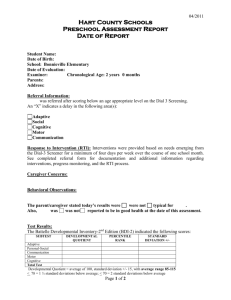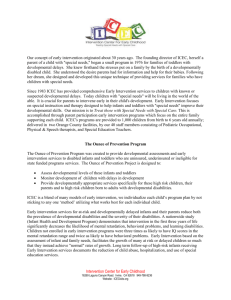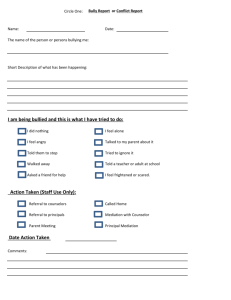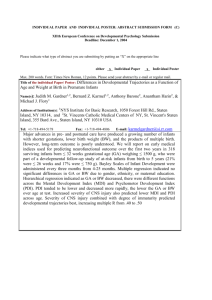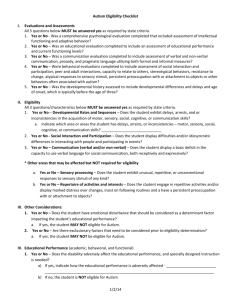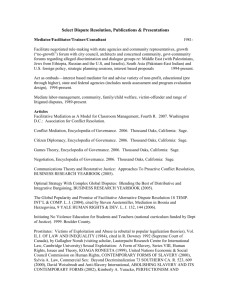Early intervention - Columbia University
advertisement
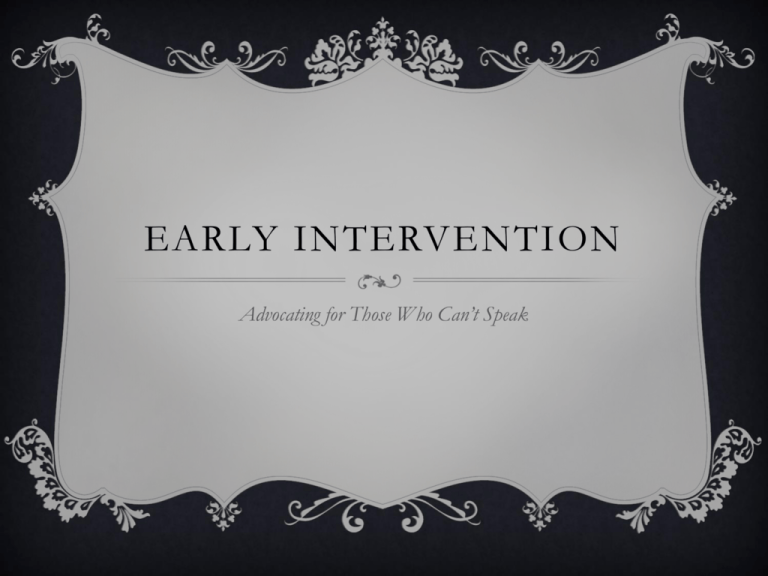
EARLY INTERVENTION Advocating for Those Who Can’t Speak WHAT IS EI? EI is a comprehensive interagency program that supports children up to age 3 with developmental delays in their efforts to realize their full potential. It reduces the likelihood of delays among at-risk children It assists and empowers families to meet their child’s and their own needs It entitles children regardless of race, ethnicity, or income to services HISTORY OF EI Brown v. Board of Education 1954: established universal right of all children to a decent education Project Head Start 1964: public policy effort to improve school readiness and social development of disadvantaged children The Education for All Handicapped Children Act 1975: ensured all children should receive a free and appropriate education HISTORY OF EI Individuals with Disabilities Education Act (IDEA) 1986: reauthorization of The Education for All Handicapped Children Act that now mandated public schools to serve children with disabilities starting at age 3 Part H (1987-96), Part C (1997 on): created services and supports in all 50 states and US territories creating the early intervention system. This also allowed states to extend early intervention to at risk children (VLBW, children born to mothers with MR, etc) In NY state, Early Intervention Program was established under Article 25 of the Public Health Law in July of 1993 HOW DO YOU REFER TO EI? Children under age 2 can be referred by their doctors, child care agencies, social service workers, community –based agencies, and by their parents Referral form with instructions: www.nyc.gov/html/doh/downloads/pdf/earlyint/ei-referral-form.pdf Contact your EI official: 1-800-522-5006; in New York City–311 Sample letter for parents to refer their own child: http://www.health.state.ny.us/publications/0532/sample1.htm WHAT HAPPENS AFTER A REFERRAL? 1. Early Intervention Official will assign an initial service coordinator 2. If the child is found to be eligible, an Individualized Family Service Plan (IFSP) will be created 3. If not eligible the service coordinator should explain to the parent how to access other services and/or how to appeal the decision 4. Reevaluate the IFSP every 6 months 5. Preparation for transition: coordinating service providers, if necessary contacting Committee on Preschool Education (CPSE) in the child’s school district WHAT SERVICES ARE AVAILABE? Special Instruction Occupational Therapy Speech Therapy Physical Therapy Psychological Services Family Training Counseling AssistiveTechonology Respite Services IS EI EFFECTIVE? EI increases the developmental and educational gains for the child and improves the functioning of the family Children in EI need fewer special education services later They are held back less RESEARCH SUPPORTING EI Longitudinal study of Ypsilanti Perry Preschool Project: at 19 years more finished high school, went on to postsecondary program, had employment, scored higher on reading, math, and language tests at all grade levels vs. children who did not attend program (Berruta-Clement, et al. 1984) Meta-analysis 31 studies in children <3 found EI effective in promoting developmental progress in infants and toddlers with biologically based disabilities (Shonkoff JP, Hauser-Cram P 1987) EI minimizes declines in development (Guralnick, MJ 1991) Longitudinal Study 25 years later for adults who had participated in Brookline Early Education Project found in urban group completion of program associated with >1 year additional schooling completed, fewer low income (<20,000) earners, more positive health behaviors, and less depression than matched controls (Rosenberg, et al. 2008) E A R LY I N T E R V E N T I O N M U N I C I PA L I T Y P E R F O R M A N C E DATA - N E W YO R K C I T Y Federal Fiscal Year Evaluation Criteria 2008 2007 2006 2005 1: Percent of children receiving services 30 days or less from the date of the authorizing Individualized Family Service Plan 1 78.0% 79.2% 85.5% 92.7% 2: Percent of children receiving services in natural environments 93.2% 92.6% 92.5% 90.2% 69.3% (n=293; 95% C.I. = (63.65%, 74.52%)) N/A 70.6% 4A: Percent of families participating in Part C who report that early intervention services have helped the family know their rights2,3 72.16% (n=176; 95% C.I. = (64.92%, 78.64%)) 63.1% (n=293; 95% C.I. = (57.33%, 68.68%)) N/A 65.2% 4B: Percent of families participating in Part C who report that early intervention services have helped the family effectively communicate their children's needs2,3 68.18% (n=176; 95% C.I. = (60.75%, 74.99%)) 78.8% (n=293; 95% C.I. = (73.71%, 83.37%)) N/A 82.6% 4C: Percent of families participating in Part C who report that early intervention services have helped the family help their children develop and learn2,3 79.55% (n=176; 95% C.I. = (72.82%, 85.24%)) WHY MAKE CHANGES? Exploding costs to the state for EI: -previously, state paid for all services regardless of parents’ income level -75,000 children participating in EI, each costing the state 9,000$ annually -other states pay 4,000$ per child EXPLOSION IN EI COSTS BUDGET CUTS AND WHAT THEY MEAN SPECIFICALLY FOR ELIGIBILITY 2010-2011 Budget Cuts and regulation changes (finalized June 3): 1. Parent fees-previously all covered by the state regardless of income level 2. Decreasing reimbursement rate to providers by 10% for homebased services 4.. Providers/Agencies to bill Medicaid or private insurers directly 5.. New eligibility criteria 6.Use of ABA aides 7. New standards for provider approval HOW ARE OUR PATIENTS AFFECTED? Parent fees: State proposes a “Medicare-like” funding structure where 80% of funding would come from the state and counties and 20% would be from parents and health insurers Families earning less than 250% of the Federal Poverty Level are exempt (= 46,000$ a year for a family of 3) Health insurers would need to cover the first 5,000$ in EI costs HOW IS THIS A PROBLEM? Payments would need to be made quarterly If a parent missed one payment the child will lose EI services and become ineligible Families must now provide proof of income, otherwise they have to pay at the highest fee level which could impede the children of homeless families, children in foster care, and particularly the children of undocumented immigrants from access to services DEFINING DEVELOPMENTAL DELAY State definition: a child who has not attained developmental milestones expected for the child’s chronological age, adjusted for prematurity in one of the following areas 1. cognitive 2. physical 3. communication 4. social or emotional development 5. adaptive development At three months At six months • turn their heads toward bright colors and lights • move both eyes in the same direction together • recognize bottle or breast • react to sudden sounds or voices • make cooing sounds • make fists with both hands • grasp toys or hair • wiggle and kick with arms and legs • lift head and chest when on stomach • smile At twelve months: • follow moving objects with their eye • turn toward the source of normal sound • reach for objects and pick them up • switch toys from one hand to the other • sit without support • pull to a standing position • crawl • drink from a cup • play peek-a-boo and patty cake • wave bye-bye • play with their toes • help hold the bottle during feeding • hold out their arms and legs while being dressed • recognize familiar faces • put objects in a container know five or six words • stack two blocks • babble At one and 1/2 years At two years • like to pull, push and dump things • use two-tothree-word sentences • follow simple directions ("Bring the ball") • say names of toys • pull off shoes, socks and mittens • like to look at pictures • make marks on paper with crayons • feed themselves • walk without help • step off a low object and keep balance • recognize familiar pictures At three years • walk up steps (alternating feet) • ride a tricycle • put on their shoes • open door • turn one page at a time • carry something while walking • feed themselves with a spoon • play independently • use three-to-five-word sentences • turn 2-3 pages at a time • name at least one color correctly • like to imitate their parent • are toilet trained • identify hair, eyes, ears and nose by pointing • build a tower of four blocks • show affection • play with other children for a few minutes • repeat common rhymes ELIGIBILITY Previously: 33% delay in one functional area or 25% delay in two functional areas Now: 2 standard deviations below the mean in one domain or 1.5 standard deviations below the mean in two separate domains For language specifically, must show delays in both expressive and receptive language or in one with the presence of specific predictors of continued language delay PREDICTORS OF CONTINUED DELAYS Language Production Particularly small vocabulary for age Less diverse vocabulary particularly in regard to verbs Preponderance of general all-purpose verbs (such as "do," "make," "want," "go") More transitive and fewer intransitive verbs (such as "give ball") Language Comprehension Presence of 6-month comprehension delay Large comprehension-production gap with comprehension deficit PREDICTORS OF CONTINUED DELAY Phonology Few prelinguistic vocalizations Limited number of consonants Limited variety in babbling structure Fewer than 50% consonants correct (substitution of glottal consonants and back sounds for front) Restricted syllable structure Vowel errors Imitation Few spontaneous imitations Reliance on direct model and prompting in imitation tasks of emerging language forms PREDICTORS OF CONTINUED DELAY Play Primarily manipulating and grouping Little combinatorial and/or symbolic play Gestures Few communicative gestures, symbolic sequences, or supplementary gestures Social Skills Behavioral problems Few conversational initiations; interactions with adults more than peers Difficulty gaining access to activities Health and Family History Recurrent otitis media Family history of persistent problems in language learning WHO DOES THIS AFFECT? Mainly affects patients with language delays A child with a delay of 25% or 1.5 standard deviations below the mean in two aspects of a single domain no longer qualifies for EI A child that qualifies because he or she meets the criteria of a delay 2 standard deviations below the mean can lose services if there is improvement in any aspect of that domain EXAMPLES A child with a delay of 1.5 standard deviations in expressive language and 1.5 standard deviations in receptive language with no other delays is not eligible A child with a score of 2 standard deviations below the mean in expressive language but no (or less significant) delay in receptive language is not eligible A child that starts out 2 standard deviations below the mean in expressive and receptive language could lose services with improvement in one of those aspects D O H C L I N I C A L P R AC T I C E GUIDELINES FOR C O M M U N I C AT I O N D I S O R D E R S Severe language delay: Children < 18 months: • Has not reached any of the normal language milestones expected for children in the next younger age range and none of the upper limits expected for the child’s age range SEVERE LANGUAGE DELAY CONTINUED Children 18-36 months: • • • • No words by 18 months Less than 30 words by 24 months No two word combinations by 30 months Documented presence of known predictors of developmental delay in language production, comprehension, phonology, imitation, play gestures, social skills, health and family history W H AT H A P P E N S T O T H E C H I L D R E N A L R E A DY E N RO L L E D ? All children enrolled prior to June 3rd do not need to meet the new eligibility criteria until the EI official requests a new evaluation New evaluations cannot be done before six months into the program OR there is an observable change that may indicate that the child is no longer eligible WHAT CAN WE DO? Email state legislators: sample letters for parents as well as others can be found through Advocates for Children New York at http://capwiz.com/iacny/state/main/?state=NY Write letters/call your state legislators: to find your State Senator http://www.senate.state.ny.us/senatehomepage.nsf/senators?OpnForm To find your NY Assembly member go to: http://www.assembly.state.ny.us/mem/ ADDITIONAL RESOURCES FOR OUR PA T I E N T S A N D PA R E N T S Early Childhood Direction Centers: www.vesid.nysed.gov/specialed/transition/whocan.htm Parent to Parent of New York State: www.parenttoparentnys.org Other sites for parent information: www.taalliance.org www.advocacycenter.com www.advocatesforchildren.org www.resourcesnyc.org FURTHER RESOURCES Advocacy Services: www.cqc.state.ny.us Mediation: If with the new changes in eligibility a child is deemed to no longer be eligible parents can request mediation Parents can send a letter to their EI official to ask for mediation , EI official then notifies Community Dispute Resolution Center The mediation process must be completed within 30 days of the Community Dispute Resolution Center receiving the request If an agreement is made then a written agreement is prepared detailing the services to be provided If no agreement is reached then parents can request an impartial hearing STEPS FOR MEDIATION Parents can send a letter to their EI official to ask for mediation EI official then notifies Community Dispute Resolution Center The mediation process must be completed within 30 days of the Community Dispute Resolution Center receiving the request If an agreement is made then a written agreement is prepared detailing the services to be provided If no agreement is reached then parents can request an impartial hearing More info at: New York State Dispute Resolution Association www.nysdra.org www.nyhealth.gov/publications/0532/index.htm REFERENCES Early Intervention. New York City Department of Health and Mental Hygiene. 22 February 2011 <http://nyc.gov/html/doh/html/earlyint/earlyservices.shtml>. Early Intervention. New York City Department of Health and Mental Hygiene. 22 February 2011 <http://nyc.gov/html/doh/html/earlyint/earlydif.shtml>. Early Intervention Program. New York State Department of Health Information for a Healthy New York. 22 February 2011< http://www.health.state.ny.us/ >. Early Intervention Program. New York State Department of Health Information for a Healthy New York. 22 February 2011< http://www.health.state.ny.us/ >. Early Intervention Program. New York State Department of Health Information for a Healthy New York. 23 February 2011 <http://www.health.state.ny.us/community/infants_children/early_intervention/ei_revised_regulations_webinar1_overview_faqs.htm>. Early Intervention Program. New York State Department of Health Information for a Healthy New York. 23 February 2011 <http://www.health.state.ny.us/statistics/community/infants_children/early_intervention/local_program_performance/n ew_york_city.htm#three>. Early Intervention Program. New York State Department of Health Information for a Healthy New York. 24 February 2011 <http://www.health.state.ny.us/community/infants_children/early_intervention/memoranda/200502/eligibility_criteria.htm>. Early Intervention Program. New York State Department of Health Information for a Healthy New York. 25 February 2011 <http://www.health.state.ny.us/community/infants_children/early_intervention/memoranda/2005-02/appendix_f.htm>. Early Intervention Program. New York State Department of Health Information for a Healthy New York. 25 February 2011 <http://www.health.state.ny.us/community/infants_children/early_intervention/memoranda/2005-02/appendix_g.htm>. REFERENCES Ramey CT, Ramey SL. “Early Intervention and Early Experience.” American Psychologist. 1998; Vol 53 (2): 109-120. Bailey DB, Gebbeler K, Scarborough A, Spiker D, Mallik S. “First Experiences with Early Intervention: A National Perspective.” Pediatrics. 2004 Sep; 114 (3): 896. Palfrey JS, Hauser-Cram P, Bronson MB, Warfield ME, Sirin S, Chan E. “The Brookline Early Education Project: A 25 Year Followup Study of a Family-Centered Early Health and Development Intervention.”Pediatrics.” 2005 Jul; 116 (1): 144-52. Early Intervention Scheduled for More Cuts in State Budget. New York State Speech-Language-Hearing Association, Inc. 24 February 2011 <http://www.nysslha.org/i4a/headlines/headlinedetails.cfm?id=52>. Meeting the Health Care Needs of New Yorkers. Division of the Budget New York State. 25 February 2011. <http://www.budget.state.ny.us/pubs/archive/fy0304archive/fy0304littlebook/health.html>. Fertig, Beth. “Schools Chancellor Says Cuomo’s Budget Cuts are Unjust.” WNYC News Blog 15 February 2011: WNYC. Weaver, Teri. “First Look at Cuomo’s Proposed Budget Shows Cuts, Consolidation.” The Post Standard 1 February 2011: The Post Standard. Important Action Alert: Oppose Harmful Changes to Early Intervention. Lublin, Nina. Resources for Children with Special Needs. 23 February 2011 <http://www.resourcesnyc.org/advocates039-voices-blog/important-action-alert-oppose-harmful-changes-earlyintervention>.


